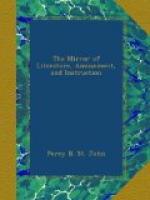Though I am as romantic a being as ever breathed on the face of this beautiful earth; yet, I will promise the reader, that in detailing the events of an interesting day, I will not tinge them with that colouring; yet, such a glorious bard as Wordsworth could, alone, do justice to our excursion. Leave him to wander alone in that woody dell, with the thrilling picture spread around him—the sinking walls of elaborate Gothic, clouded by the hanging woods—the rural dwellings of the illiterate peasantry scattered below the templed mount—and the mourning stream and its rustic bridge—thus entranced, his fairy spirit would pour forth a flood of pensive and philosophic song.
It was on the dawning of a fine morning in August, that I left the brick-and-mortar purlieus of home, and in company with two young friends, commenced this excursion. The diversified chain of the Hambleton Hills, bounding the fruitful valley of Mowbray, rose at the distance of six miles before us; and whose summit we intended reaching before breakfast. The varying aspect of these rocky eminences requires the descriptive charms of Sir Walter Scott, or the pencil of Salvator Rosa, to do them justice. Within two miles of them, you might imagine yourself in the ruins of the Roman amphitheatre, whose circular walls reared their dark-gray forms to the heaven; and the inimitable description which Byron has given us of that edifice, occurs to the recollection; though no waving weeds and dew-nurtured trees crown the apparent ruin—
“Like laurel on the bald first Caesar’s head.”
On a nearer view, they change their appearance, and you might suppose that the remains of some fortified castle, typical of the feudal system, looked over the heather which clothes their rocky sides; whilst the detached pieces of rock, which rolled from the summit eighty years ago, appear amongst the furze, like the tombs of Jewish patriarchs in the valley of Jehosaphat at Jerusalem, darkened by the lapse of ages. To the right of our path lay the solitary and frail memorials of the monastery of Hode, founded by Roger de Mowbray, and afterwards attached to the abbey of Byland. Shortly after passing Hode, we arrived at the base of Hambleton, and began to ascend its rocky front; we had climbed half the ascent, when, on cautiously turning ourselves, an indescribable picture presented itself in the vale and its objects below; the solemn silence of the early hour—the first greeting of the morning sun—the glittering and distant lake of Gormire, guarded by towering hills to the right—and, to the left, rocks which have stood whilst generations of heroes and kings have passed away; and, beyond this vivid scene, in dim perspective, arose the western hills, tinged with delicate blue, and scarcely discernible from the clouds which floated over them. Even the enraptured travellers, who stood gazing from the summit of Mont Blanc, were not more delighted than the enthusiastic trio who looked from the brow of Hambleton




